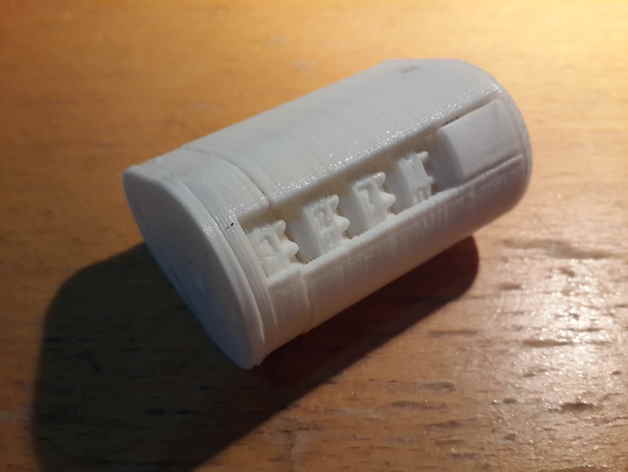
Filament travel counter (proof of concept only)
thingiverse
Have you ever longed for total insight into filament availability so you can masterfully plan major 3D prints and spool changes? I aimed to resolve that by hooking a compact system onto the 3D printer to keep track of consumed filament. This is an experimental proof for purely mechanical design. Filament is pulled through the device by the extruder, then the filament makes a wheel turn, which in turn drives a series of gears that rise. The wheel and gears are dimensioned to record the length of passing filament in centimeters. One kilogram of 1.75 millimeter filament weighs 330 meters for PLA and 400 meters for ABS. My findings were: 3D-printed gears perform fairly well; printed parts exhibit low friction, making gears rotate freely, and even a 3D-printed axle is low-friction enough for non-load-bearing gears. Unfortunately, because of the low friction, filament slips past the wheel without spinning it. Some other material like an elastic band has to be added to generate sufficient friction between the wheel and filament for it to function. Much precise design is necessary to prevent jamming the geneva mechanisms; essentially rounded edges are required anywhere two non-coplanar gears meet. A significant portion of the cause for jamming is size tolerances - every printer, and even slicer settings, will lead to different print sizes and also printing imperfections that affect mechanism performance. This isn't a completed design for filament travel counter; it's purely an experimental model. It only counts up to four digits, meaning it'll stop at 99.99 meters of consumed filament before rolling over. The system is sized for 1.75 millimeter filament (one extra dial needs to be added for work with 1 kilogram spools - this can easily be achieved). There's no mounting mechanism attached. I have made a decision not to proceed working on an all-mechanical filament counter. While the counter operates in principle, such tremendous effort is involved fine-tuning the design; indeed it would just be more effortless to utilize a 3D print manager that keeps track of filament usage through software (Even though there are several benefits associated with having an entirely mechanical count: one example is you can manufacture separate counters for every spool, granting you the ability to swap out spools without dealing with the issue of messing up your filament counter). Link for video action - https://www.youtube.com/watch?v=w5Znb5UNO8I Instructions You will have to print out these specified quantities of parts: 1x frame1.stl 1x frame2.stl 1x driver.stl 4x geneva.stl 4x dial_numbered.stl Additionally, you'll require: 1 small elastic band or self-adhesive tape or some kind of rubber material for wrapping on the drive wheel.
With this file you will be able to print Filament travel counter (proof of concept only) with your 3D printer. Click on the button and save the file on your computer to work, edit or customize your design. You can also find more 3D designs for printers on Filament travel counter (proof of concept only).
